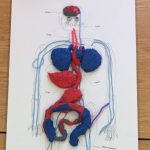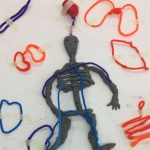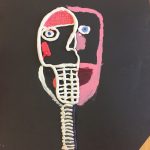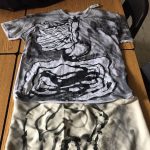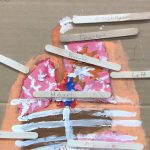When I was in high school, I used to love “proving theorems” (explaining why something is true) in geometry through logic and reasoning using established axioms or properties like reflexivity (a=a), symmetry (if a=b, then b=a) and transitivity (If a=b and b=c, then a=c). That was the only context in which I was familiar with “reflexivity.” Well, that and mirrors! However, the concept of reflexivity is very important in #LearningSciences and qualitative research. To be reflexive means that you not only reflect on your own biases and perspectives and how those shape how you interact with the world, you also reflect how the system or structure of society influences and is influenced by these biases. Then this double reflection is used to help you modify your actions or perceptions–“examination or action ‘bends back on’, refers to, and affects the entity instigating the action or examination” (Wikipedia). It is rare to read a research study journal article or book where the word reflexive is not used at least once. Since qualitative researchers are “passionate participants,” it is essential that they embrace a state of reflexivity because the researcher’s biases and worldviews “may influence their interpretation of participants’ perceptions” (Bloomberg and Volpe, 2016, p. 54). It needs to be ongoing, iterative and through dialogue with participants. Our worldview and biases affect what we value and what we choose to measure; they can even make us blind to what the data is showing. It is like looking in the mirror, but instead of just seeing our reflection, we see all the experiences, language, privilege, cultural objects, etc. that create our epistemological (what is knowledge?), ontological (what is the nature of reality?) and axiological (what is good/valuable?) beliefs. It is both as simple and profound as that reflexive property of a = a. #100LSreflections #100dayproject 18/100
Qualitative Research
I teach my grade 9 science students the difference between quantitative and qualitative data. It’s one of the first concepts of the semester. Quantitative = numbers, measurements. Qualitative = words, descriptions. Now I know that that are also quantitative and qualitative research methodologies and they are very different–and both use measurements and descriptions. As opposed to typical empirical research (quantitative methodology) where a hypothesis is tested by controlling the variables, then changing the independent variable to see the consequences on dependent variable, qualitative methodology involves studying social situations in naturalistic settings to understand or “make sense” of them. Depending on the research purpose and questions, the researchers may examine the undisturbed system in place or they may make an “intervention” or purposeful change to the system and then study the effects of that intervention. Qualitative researchers strive to “make the world visible.” Brene Brown has a beautiful way of describing this. She calls qualitative researchers, herself included, “collectors of stories,” and the stories are “data with a soul.” The data are collected directly from the participants. Brene uses a type of qualitative methodology called grounded theory. This means that she interviews many people about their lived experiences and inductively develops theories based on the common themes that arise from the data–therefore the theories are “grounded” in real life. Other types of qualitative methodology include case study, ethnography, phenomenology, narrative inquiry, action research, postmodernism/poststructuralism and critical theory research and more. In all of these methodologies, the qualitative researcher is typically not separate from the study. He or she is a “passionate participant” whose role is to reflexively examine and give voice to all other participants’ perspectives so that a comprehensive description of the research situation can be made. This passionate participate is looking forward to the privilege of collecting stories of student agency for activism (just like I collected these rocks). #100LSreflections #100dayproject 17/100
via IFTTT
School Tasks
Writing report cards tonight. So here’s one of my fav quotes. #100dayproject #100LSreflections 15/100
via IFTTT
Extra works of art
This post is “extra” as the kids say… I really just want to share and celebrate these amazing “human body system” projects from my grade 10 Vocational Science students. It’s not just that they all turned into works of art. It’s also the engagement and thinking that went into their work. Nearly all students were highly intellectually engaged in this project. So I tried to find a way to relate it to Learning Sciences. It reminds me of the diversity of research topics and methods that I have read in the articles for my courses and for my own work and that my fellow students in my cohort are proposing. To name only a few: online learning–both engaging online teachers in communities of practice and using learning analytics to improve students success, project-based learning in medical school, professional learning communities in secondary schools, policies for mathematics curriculum at the national level, open educational practices within K-12 schools, teacher and administrator identity and agency in research partnerships, makerspaces and many more. The research methodologies are very diverse as well. Like these human body projects, each research study is both a work of art and very personal to the graduate students. Like I tell my own students, you need to deeply care about and want to make a positive impact on the issue you choose for your inquiry. The topic must be able to sustain your energy and passion for a long time. #100LSreflections #100dayproject 14/100
Dehiscent
Here’s a fun new word. Dehiscent. “I divide, split open, gape.” It is used in botany to mean the “spontaneous opening at maturity of a plant structure, such as a fruit, anther or sporangium, to release its contents.” Roth uses the word in the context of an event*-in-the-making. We talked a lot in our Advanced Learning Sciences course last summer about utterances. The meaning of what someone says is not clear until the utterance has been heard and interpreted by the other person. “A locution is one-sided, whereas an utterance is two-sided, involving an articulation and its social evaluation on the part of the listener” (Volõsinov, 1930 in Roth, 2013, p.414). Roth utilizes this concept while analysing a video of an exchange between a teacher and student to say that we don’t know what will happen when the teacher asks the question. We don’t know who will volunteer to answer, we don’t know who the teacher will call on and, when she does call on the student, we don’t know what he will say or do. Roth analyzes this exchange in tiny video segments to learn about and then describe the event*-in-the-making. The meaning of the original question is not known until the student responds. This response is dehiscent–naturally opening and revealing the meaning of the curriculum that is now the event. You might ask why–what is the point of this distinction? It has something to do with the idea that when the your change your perspective on the event, then both participants are teacher-learner and learner-teacher. “They make the event and are made by it…Mrs. Winter is teaching geometry as much as learning to teach geometry; and Connor is learning geometry as much as allowing Mrs. Winter to learn to teach geometry” (p412). Think about your own practice. Did you know how to ask questions well at the beginning? I didn’t. I am still learning how to ask good questions to elicit the learning or conversation or thinking I want. The students teach me how to ask questions by their responses. This happens whether you intend to learn or not. This is why it takes me so long to write. These ideas do not come easily to me, but I am fascinated by them. #100LSreflections #100dayproject 13/100
via IFTTT
Dialectic (Part 3)
Dialectic (Part 3)–I recently sent my critical friends (a graduate study group who have become close friends) a text that said, “This morning I am embracing the dialectic. Apparently it is possible to be both elated and devastated; in my senses and disembodied; conciliatory and vengeful.” (I can become overly dramatic in text-form…much more so than in person!) It was the mixture of emotions that resulted from having to admit that I would not be able to live up to all the things I had committed to (both personally and professionally) and that I needed help. Graduate school and full-time work at the same time is hard. Much harder than I thought it would be. Once I finally asked for help, my friends, family and colleagues worked with me to figure out how cut back on responsibilities and to extend deadlines so that I could manage. I am humbled by and grateful for their love, support and understanding. I still worry that I have bitten off more than I can chew and, at the same time, frustrated by my slow progress. I have been listening to Brene Brown a lot and this quote speaks to me. We are all struggling with the dialectic aspects of being human. “Most of us are brave and afraid at exactly the same time, all day long.” The picture is from Agawa Rock Pictographs in Lake Superior Provincial Park. I visited there during my trip across Canada last summer. I was very afraid because the rock ledge was very slippery and steeply slanted to Lake Superior and no one was there but me. But I pushed myself to be brave because I wanted to see the pictographs in person…not just pictures of them. Imagine the First Nations people who painted the pictographs. I wonder if they felt both brave and afraid at the same time. #100LSreflections #100dayproject 12/100
via IFTTT
Dialectic–Part 1
Dialectic—a word I did not know before starting my EdD courses. It shows up everywhere for me now. It has several layers of meaning. The most basic is “the juxtaposition or interaction of conflicting ideas, forces, etc.” (dictionary.com). A dialectic can also be “discussion and reasoning by dialogue as a method of intellectual investigation” (merriam-webster.com). Those two meanings are just the beginning. When you embrace two conflicting or opposing ideas at the same time, you can expand your learning and develop new ideas. A couple of years ago, I went to a workshop at Rotman School of Management on integrative thinking and was introduced to the Pro-Pro chart—like a pro-con chart, except you put the pros from two competing or dialectical ideas to a solve problem into the chart. These photos are for the redesign of schooling. The dialectical ideas are a brick and mortar school vs an online school. The “cons” are not considered, at this point, because you want to make a solution that integrates these dialectical positions in a positive way. Then you find a new and transformative solution that will bring to fruition as many of the pros from both sides as possible.
Another way to look at the dialectic was in a chapter about critical pedagogical research I was reading tonight. “Critical teachers, therefore, must admit that they are in a position of authority and then demonstrate that authority in their actions in support of students. One action involves the ability to conduct research and produce knowledge. The authority of the critical teacher is dialectical; as teachers relinquish the authority of truth providers, they assume the mature authority of facilitators of student inquiry and problem posing. In relation to such teacher authority, students gain their freedom—they gain the ability to become self-directed human beings capable of producing their own knowledge” (Kincheloe, McLaren & Steinberg, 2011, p. 165). It is dialectical to use your power of authority to give power to the students to be authors of their own learning. I struggle with that dialectic every day. #100LSreflections#100dayproject 10/100
Dialectic (Part 2)
Dialectic (Part 2)—The post I wrote a couple of days ago about students engaging in activism (student-in-the-making) is also about the dialectic. Through participation in any action (Roth studied workers in a salmon cannery and commercial pilots, for example) you both change the situation/environment and are changed by it simultaneously. “The very nature of practice is its own transformation” (Roth, 2016, p.106) and “being and becoming are dual aspects of nature” (Beatty, 2009). Roth’s “dialectical materialism” is based on the writings of Marx and Engels. It’s all a little beyond my comprehension but my understanding of “materialism” is that there is real world outside of our minds–matter/material–and it is knowable (in principle). It is there, even if we don’t perceive it. If that tree falls in the forest, does it make a sound if no one is around to hear it? Yes. This “realism” is in contrast with the “idealism” philosophy which posits that what we think of as reality is created in the mind and nothing is really real because all people experience the world differently. Dialectical materialism, then, (in my limited understanding) is the idea that the everything is connected in the material of existence. We are all connected to the natural world and our actions act on the world, and the world acts on us. Our thoughts are included. Even our thoughts are created and transferred in our material brains and perhaps also in all parts of our body (and maybe even the metaphysical body as well…but that’s beyond our talk today!). This also includes the ideas of interconnectedness of systems and the need to study all parts of system to understand what is happening. We must view “change as interaction among components of complete systems, and [see] the components themselves not as a priori entities, but as both products and inputs to the system” (Gould, 1990). The whole “system” is the minimal unit of study, because if you take out even one part or change even one part of the system, it affects all other parts. And, now, we have arrived at “activity theory”! #100LSreflections #100dayproject 11/100
Everything is dialectic
In-the-making
 I thought I would write these posts chronologically, but this quote (Wolff-Michael Roth, 2016, p.116) is speaking to me today. This is from one of the papers I read for my literature review I wrote this last December and it is about taking the theoretical perspective that activism is learning. When you engage in productive activity that benefits society, you are simultaneously changing and being changed by the practice of activism. Or the practice of anything, really. The quote describes how we experience life–it’s always changing, just like that river with all its eddies and turbulences. Everything changes. So when trying to study societal actions like education, we have a hard time narrowing the measurement or observation to something static. It’s pretty problematic to stop the river to study the individual “states”, but if we try to observe the flow of the river or how the river changes, it’s more authentic. If we are looking at students engaged in activism, that student is both engaging in the action and being changed by engaging in the action; he is a not just the subject of research, but a “subject-in-the-making.” Simultaneously, the researcher is a researcher-in-the-making; the teacher is a teacher-in-the-making and the environment is also in the process of undergoing change. I guess this quote is speaking to me because I am experiencing a lot of change lately–not just professionally, but also personally. I am Susan-in-the-making. #100LSreflections #100dayproject 8/100
I thought I would write these posts chronologically, but this quote (Wolff-Michael Roth, 2016, p.116) is speaking to me today. This is from one of the papers I read for my literature review I wrote this last December and it is about taking the theoretical perspective that activism is learning. When you engage in productive activity that benefits society, you are simultaneously changing and being changed by the practice of activism. Or the practice of anything, really. The quote describes how we experience life–it’s always changing, just like that river with all its eddies and turbulences. Everything changes. So when trying to study societal actions like education, we have a hard time narrowing the measurement or observation to something static. It’s pretty problematic to stop the river to study the individual “states”, but if we try to observe the flow of the river or how the river changes, it’s more authentic. If we are looking at students engaged in activism, that student is both engaging in the action and being changed by engaging in the action; he is a not just the subject of research, but a “subject-in-the-making.” Simultaneously, the researcher is a researcher-in-the-making; the teacher is a teacher-in-the-making and the environment is also in the process of undergoing change. I guess this quote is speaking to me because I am experiencing a lot of change lately–not just professionally, but also personally. I am Susan-in-the-making. #100LSreflections #100dayproject 8/100

